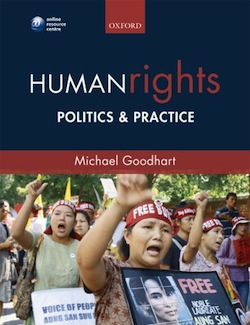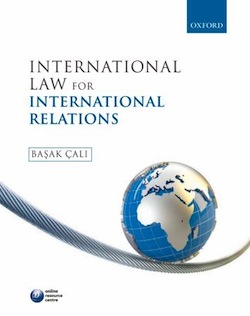
The majority of International Relations (IR) students will probably be aware that human rights and international law (IL) matter in the real world of international politics. The realist view of these things as mere ideological camouflage for undeclared interests is rapidly going out of fashion.
In its place we have liberal theories that understand IL as a set of rules and institutions co-ordinating cooperation, constructivist theories treating human rights and IL as ‘norms’ or standards of appropriate behaviour, and critical theories that see them as ‘discourses’, or kinds of knowledge about the world shaped by powerful forces. Students will also probably be aware, however, that human rights and international law are themselves academic disciplines involving intense, and often complex theoretical debate. They may wonder if they need to familiarise themselves with this specialist knowledge, or whether IR’s own approaches suffice. The two textbooks under review here provide thorough introductions to these topics, but answer this question in strikingly different ways. These answers reflect, to some degree, contrasting editorial objectives that will be important for decisions over whether to buy these books. But they also tell us something about human rights and international law themselves, a matter to which we we will return briefly in conclusion.
 Human Rights: Politics and Practice, edited by Michael Goodhardt approaches its subject as matter of politics and policy, but almost never as theory. In the first chapter Anthony Langlois provides an extremely helpful introduction to the various philosophical controversies that have surrounded human rights, but only John Barry and Kerri Woods’ impressive chapter on the environment makes any subsequent reference to them. Michael Goodhardt’s introduction explains this approach. The politics of human rights, he says, is a matter of ‘taking sides’ for or against an ‘inherently revolutionary’ challenge to ‘traditional cultures and philosophies’ (pp. 2, 4-5). As a result, the bulk of the book contains descriptive and policy-focused accounts of various human rights practices written by those who support the revolution: practitioners, ex-practitioners, and sympathetic academics (cf. those on democracy and repression, global civil society, development, globalization, forced migration, indigenous rights, and transitional justice; those on torture and human trafficking for sexual exploitation contain interesting veiled critiques of other policy positions).
Human Rights: Politics and Practice, edited by Michael Goodhardt approaches its subject as matter of politics and policy, but almost never as theory. In the first chapter Anthony Langlois provides an extremely helpful introduction to the various philosophical controversies that have surrounded human rights, but only John Barry and Kerri Woods’ impressive chapter on the environment makes any subsequent reference to them. Michael Goodhardt’s introduction explains this approach. The politics of human rights, he says, is a matter of ‘taking sides’ for or against an ‘inherently revolutionary’ challenge to ‘traditional cultures and philosophies’ (pp. 2, 4-5). As a result, the bulk of the book contains descriptive and policy-focused accounts of various human rights practices written by those who support the revolution: practitioners, ex-practitioners, and sympathetic academics (cf. those on democracy and repression, global civil society, development, globalization, forced migration, indigenous rights, and transitional justice; those on torture and human trafficking for sexual exploitation contain interesting veiled critiques of other policy positions).
All of these chapters, like those in both books, contain useful and helpfully-presented reference information (tables setting-out the roles of key institutions, chronologies of important treaties, case studies of significant events etc.), as well as comprehension and discussion questions, online revision aids, reading lists, and other handy teaching resources. What they do not do, however – with the exception of Scott Straus’ chapter on genocide, and Damien Short’s on sociological and anthropological approaches – is provide guidance for dispassionate social-scientific study of these difficult, because highly emotive and normative subjects. Indeed, those chapters that explain how to measure human rights ‘scientifically’ (‘Measuring Human Rights’, ‘Human Rights in Comparative Politics’, ‘Political Democracy and State Repression’, and ‘Economic Globalization and Human Rights’) barely mention the controversies surrounding their concepts that Langlois describes.
The main counterpoint to these supportive perspectives is provided by those who choose against some aspects of the revolutionary project. Most forceful are David Chandler’s chapter on the ‘Ideological (Mis)use of Human Rights’ and Vanessa Pupavac’s on children’s rights. Chandler argues that giving rights to those who cannot use them allows powerful international (and especially U.S.) military forces to intervene on their behalf whenever they choose. Since weak states do not make these decisions, human rights serves to both undermine the legal equality of the international system, and concentrate power in the hands of the powerful. Pupavac ranges much more widely than her title suggests, criticising those who argue that changing cultures alone can promote human rights. She makes a case that, as classical sociology and modernisation theory maintained, material and economic changes are often required for to persuade people that cultural changes will benefit them. Less confrontational is Alan J. Kuperman, who provides a highly detailed but student-friendly case-study of intervention in Bosnia, aimed to suggest that the damaging unintended consequences of such actions will often outweigh their benefits. Tim Dunne and Marianne Hanson, finally, whilst generally both sympathetic and even-handed in their introduction to how IR has approached these issues, stress how some actors are never likely to prefer security to liberty: ‘the choice is often between irreconcilable moral values’ (p.72).
Human Rights: Politics and Practice, then, is likely to be of particular use for that courses focus on practical aspects of international human rights, and that could benefit from critical perspectives inviting students to reflect on their political effects of these practices. It may be of help to those interested in human rights and normative theory, but mostly as a stock of reasons to believe that this theory is not particularly relevant for practice. It will only be of occasional interest to those interested in studying human rights from the perspective of dispassionate social science.
 International Law for International Relations, edited by Başak Çali, by contrast, insists that students do need to know about how international law approaches international relations, and sets out to provide them with such an understanding. In this it is highly successful. All of the chapters are written in a clear, accessible style suited to the non-specialist reader. They outline how international law’s principal institutions function, how it is made (via treaties, courts, customary international law, and NGO activity), how it is shaped by political processes, and what it currently says about some key topics (self-determination, secession, recognition, use of force, humanitarian law, criminal law, human rights, the environment and world trade). As an aid to understanding, almost all authors are careful to draw comparisons between legal approaches and relevant IR theories whenever appropriate (all these introduced with great clarity in introductory chapters by Fiona Adamson and Chandra Lekha Sriram, and Başak Çali). The editor makes a number of contributions to the volume, and ties together themes introduced elsewhere. Her chapters 11 and 13 include excellent case studies of fictional human rights and humanitarian situations which force students to think as lawyers: identifying legally relevant facts and analysing them with general principles.
International Law for International Relations, edited by Başak Çali, by contrast, insists that students do need to know about how international law approaches international relations, and sets out to provide them with such an understanding. In this it is highly successful. All of the chapters are written in a clear, accessible style suited to the non-specialist reader. They outline how international law’s principal institutions function, how it is made (via treaties, courts, customary international law, and NGO activity), how it is shaped by political processes, and what it currently says about some key topics (self-determination, secession, recognition, use of force, humanitarian law, criminal law, human rights, the environment and world trade). As an aid to understanding, almost all authors are careful to draw comparisons between legal approaches and relevant IR theories whenever appropriate (all these introduced with great clarity in introductory chapters by Fiona Adamson and Chandra Lekha Sriram, and Başak Çali). The editor makes a number of contributions to the volume, and ties together themes introduced elsewhere. Her chapters 11 and 13 include excellent case studies of fictional human rights and humanitarian situations which force students to think as lawyers: identifying legally relevant facts and analysing them with general principles.
For teachers and students, therefore, who are already convinced of the importance of international legal knowledge for IR, International Law for International Relations is an attractive purchase. It makes no effort, however, to explain precisely when, how and why international legal approaches may be necessary complements to those found in IR. Some may conclude as a result that nothing is lost by continuing to treat international legal phenomena as regimes, norms or discourse. One powerful argument against this is implicit throughout the text: solving problems by changing particular norms or regimes has systematic effects. That is, IR students tempted to recommend the use of international law to ‘solve’ particular issues must learn the lawyer’s habit of evaluating all possible situations in which their solution could apply. Perhaps this point could have been brought out more clearly. An important debate over whether rules and norms can be understood without understanding their place in legal systems might also have been relevant here[1].
This analytical point is also a philosophical one: to what extent should law be ‘above’ political attempts to change norms, cultures and philosophies? As we have seen, Goodhardt, like many other contemporary scholars, believes that human rights now hardly qualifies as a theory at all, and should be seen simply as a political tool. Although International Law for International Relations does not (understandably) enter these waters, many international lawyers believe (and some fear) that the same thing is happening to their discipline[2]. And indeed, justifications for this belief can be found between the lines of Çali’s own arguments. The breadth and complexity of international law, she suggests, is now so great that the convergence of viewpoints on controversial subjects like poverty and the environment is now highly unlikely in the near future (p.388). Although new principles will be needed to tackle these difficulties, it is currently unknown where these will come from (p.390). The best solution, therefore, is not legal or intellectual, but rather social engineering, or what she describes as ‘mechanisms of socialization’ (p.389). Thanks to constructivism, of course, IR scholars will know all about this future if and when it comes. However for the time being, at least, a little legal knowledge is still likely to go a long way.
—
Peter Brett is a PhD student in Politics at the London School of Oriental and African Studies. He is writing a thesis on the ‘judicialisation’ of African politics from the standpoint of interpretive political science and legal theory. His thesis examines how major political contests have moved into courtrooms, and focuses on three well-known cases from Namibia, Botswana and Zimbabwe.
[1] Benedict Kingsbury, ‘The Concept of Compliance as a Function of Competing Conceptions of International Law’, Michigan Journal of International Law 19, (1998): 345-372, and Beth Simmons, ‘International Law and International Relations: Scholarship at the Intersection of Principles and Politics’, Proceedings of the Annual Meeting (American Society of International Law) 95, (2001), 277.
[2] E.g. Anne-Marie Slaughter, Andrew Tulumello and Stepan Wood, ‘International Law and International Relations Theory: A New Generation of Interdisciplinary Scholarship’, American Journal of International Law 92, no. 3, (1998): 367-97, and Martti Koskenniemi, ‘Miserable Comforters: International Relations as New Natural Law’, European Journal of International Relations 15, no. 3, (2009), 396, 405-409.
The books herein are selected by e-IR for inclusion in our student book features solely due to their value to students – as determined by our editorial team in counsel with selected teaching academics – and not as promotional advertising on behalf of the publisher(s), who kindly provide us with the above books so that we are able to independently determine their utility. If you are a publisher and would like to bring your books to our attention, get in touch.